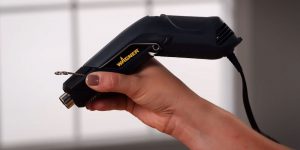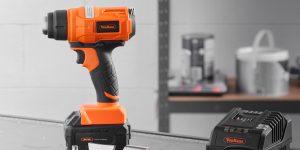As time passes, it’s common to notice that plastic surfaces around our homes, vehicles, and personal items start to fade or discolor, leading to an undesirable appearance. A solution that many overlook is the use of a heat gun to restore plastic. This method is an economical and convenient way to rejuvenate these surfaces and breathe new life into them.
Heat guns offer a high degree of control, which means you can easily manage the intensity and direction of the heat to suit specific restoration needs. In this guide, I will take you through the step-by-step process of using a heat gun to restore plastic, allowing you to rediscover the true beauty of your belongings.
What types of plastic can be restored using a heat gun?

There are several types of plastic that can be effectively restored using a heat gun, though the method is not universally applicable. Here’s a simple guide to help you understand:
Types of plastic you can restore
- Polyethylene (PE): This is a common type of plastic often used for outdoor furniture, storage bins, and playground equipment. It responds well to the heat gun restoration method.
- Polypropylene (PP): Another widely used plastic, PP is found in car bumpers, kitchenware, and garden furniture. Like PE, it can also be restored with a heat gun.
- Acrylonitrile butadiene styrene (ABS): Known for its toughness, ABS is used for items like drain pipe systems and protective headgear. ABS can be rejuvenated with a heat gun.
Types of plastic you should avoid
- Polystyrene (PS): Commonly used for disposable cutlery, CD cases, and plastic models. It has a low melting point, which makes it unsuitable for heat gun restoration.
- Polyvinyl chloride (PVC): While it’s widely used in plumbing and electrical cable insulation, PVC releases toxic fumes when heated, making it unsafe to restore with a heat gun.
- Polycarbonate (PC): This type of plastic is often used in eyewear and digital disks. However, it can become discolored and brittle when heated.
Preparation
Before beginning the restoration process with a heat gun, it’s important to adequately prepare the plastic surface and the surrounding area. Here’s a step-by-step guide:
- Clean the surface: First, remove any dirt or debris from the plastic surface. Use a gentle cleaning solution and a soft cloth to scrub the surface.
- Remove old coatings: If the plastic surface has any old paint or other coatings, these need to be removed.
- Protect adjacent areas: Apply heat-resistant tape or protective sheets to surrounding areas that could be sensitive to the heat from the gun or the restoration process. This includes glass, metal, and other plastic surfaces.
- Prepare your safety gear: Safety should be your first concern. Prepare your heat-resistant gloves, safety goggles, and a well-ventilated work area.
- Test the process: Find a small, hidden area of the plastic to practice.
Restoring faded plastic

Once your preparation is complete, it’s time to restore faded plastic with a heat gun. Here’s a step-by-step guide:
Restoration steps
- Setting the heat gun: Adjust your heat gun to a low setting to start with – usually around 200°F (93°C) is a good starting point. It’s crucial not to set the heat too high initially, as it could cause the plastic to warp or burn.
- Testing: Apply the heat to your test area, holding the gun around 6-8 inches away from the surface.
- Observing the reaction: Watch for the color change. The faded plastic should begin to darken.
- Proceed with the restoration: Once you’ve determined the correct temperature, apply the heat to the rest of the plastic surface.
- Let it cool: After heating, allow the plastic to cool naturally.
By following these steps carefully, you’ll be successfully restoring plastic with a torch, returning your faded items to their former glory, and giving them a fresh and vibrant look.
Finishing touches
The plastic restoration process doesn’t end with the heat gun treatment. To ensure your newly restored plastic retains its appearance for a long time, you might consider taking the following additional steps:
- Sanding: After the plastic has cooled, you may notice some rough or uneven spots. Using fine-grit sandpaper, lightly sand the surface to even it out. Remember, the goal is to smooth the surface, not to remove material.
- Polishing: Once you’re satisfied with the smoothness, apply a plastic polish. This will not only enhance the shine but also help to protect the surface from future damage.
- Coating: For added protection, consider applying a clear plastic coating.
- Regular cleaning: Maintain the restored surface by cleaning it regularly.
- UV protection: Prolonged exposure to the sun’s UV rays can cause the plastic to fade over time, leading to the need to restore sun-damaged plastic.
Why is plastic fading?
Plastic fades over time due to several factors. The most significant is exposure to the sun’s ultraviolet (UV) radiation, which breaks down the plastic’s molecular structure, leading to discoloration and weakening. Other causes include oxidation, a natural process that occurs when plastic is exposed to air over time, and environmental factors like extreme temperatures, air pollutants, and abrasive materials. These factors contribute to the gradual wear and tear, resulting in faded plastic.
Safety precautions
Using a torch to restore plastic can be a rewarding process, but it’s important to prioritize safety:
- Always wear heat-resistant gloves to protect your hands and safety goggles to shield your eyes from any unexpected plastic debris.
- Keep the heat gun moving to evenly distribute the heat and prevent the plastic from warping or burning.
FAQ
Can a heat gun remove deep scratches or gouges on plastic surfaces?
A heat gun can really help to diminish the appearance of light scratches, as the heat can make the plastic swell slightly, filling in minor scratches.
What are the signs that the plastic is overheating?
If plastic is overheating, you might notice several signs: the color might darken excessively or unevenly, the surface might bubble or warp, or there could be a burning smell.
Can I use a heat gun to restore painted plastic surfaces?
Yes, you can, but it’s important to note that the paint might discolor or peel off under the heat. If the plastic is painted, removing the paint first before using a heat gun for restoration is generally recommended.

















